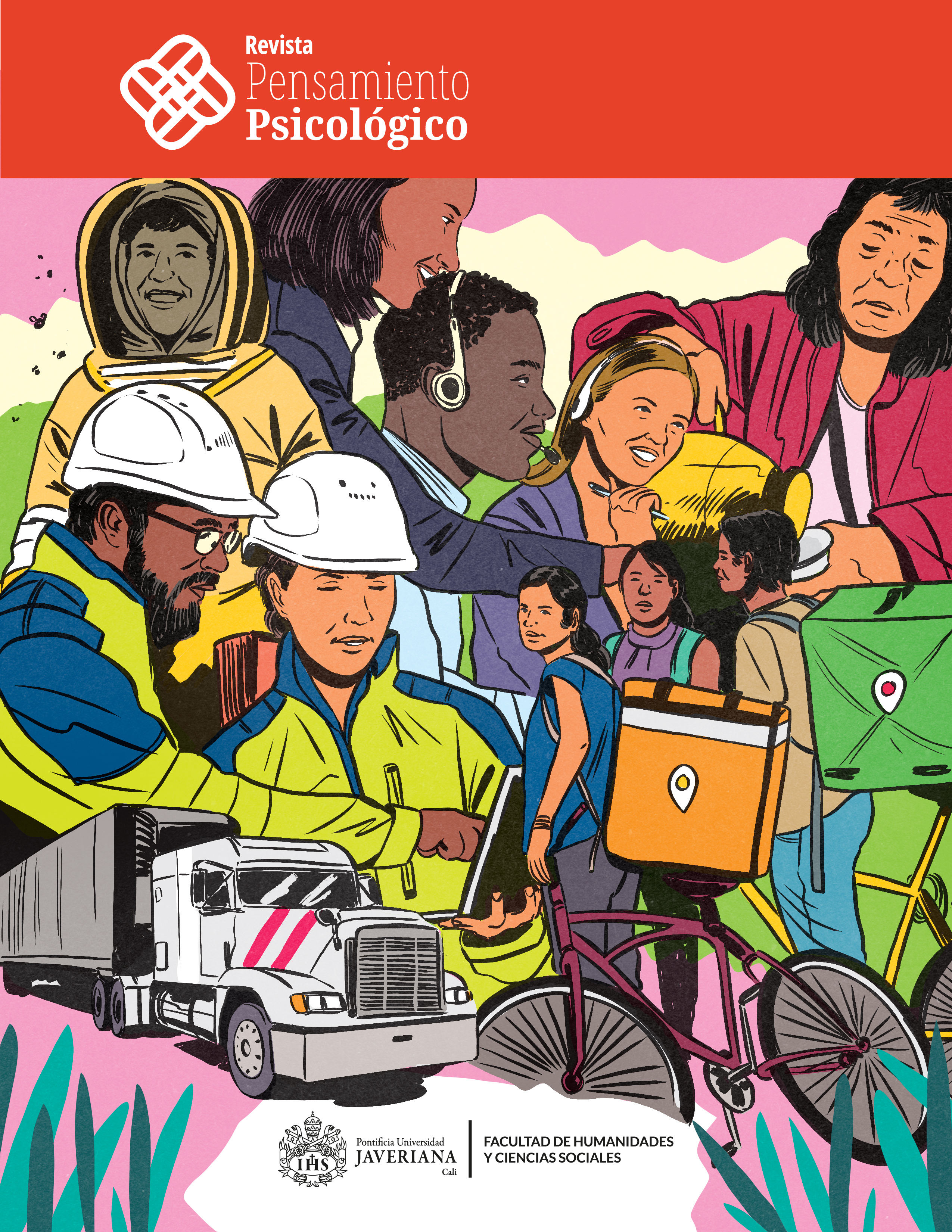Monográfico en psicología, género y sexualidad Segunda parte: Nodo de Investigación Ascofapsi
##plugins.themes.bootstrap3.article.main##
##plugins.themes.bootstrap3.article.details##

Este trabalho encontra-se publicado com a Licença Internacional Creative Commons Atribuição 4.0.
Referências
Aglipay, F. A. (2014). The Cass' Theory of Sexual Identity Formation: A Study of the Complexities of Queer Identity Development. Psychology Research, 4(6), 411-418. https://doi:10.17265/2159-5542/2014.06.001
Astudillo, P. y Faúndez-García, R. (2021). Una aceptación silenciosa: actitudes de profesores en torno a la diversidad por orientación sexual, identidad y expresión de género (OSIEG) en Chile. Archivos Analíticos de Políticas Educativas, 29(2), 165. https://dialnet.unirioja.es/servlet/articulo?codigo=8529003
Cass, V. C. (1979). Homosexual identity formation: A theoretical model. Journal of homosexuality, 4(3), 219-235. https://doi.org/10.1300/J082v04n03_01
Cass, V. C. (1984). Homosexual identity formation: Testing a theoretical model. Journal of Sex Research, 20(2), 143-167. https://doi.org/10.1080/00224498409551214
Castro, J. A., Vinaccia, S. y Ballester-Arnal, R. (2018). Ansiedad social, adicción al internet y al cibersexo: su relación con la percepción de salud. Terapia Psicológica, 36(3), 134-143. http://dx.doi.org/10.4067/S0718-48082018000300134
Coleman, E. (1987). Assessment of sexual orientation. Journal of Homosexuality, 14(1-2), 9-24. https://doi.org/10.1300/J082v14n01_02
De Cecco, J. P., & Shively, M. G. (2014). From sexual identity to sexual relationships: A contextual shift. In Origins of sexuality and homosexuality (pp. 1-26). Routledge.
Denton, J. M. (2023). Queer theory: Deconstructing sexual and gender identity, norms, and developmental assumptions. In Rethinking college student development theory using critical frameworks (pp. 55-63). Routledge.
Galvis-Rivas, A. M., Gómez-Rocha, J. N., Orcasita, L. T. y Rueda-Toro, J. S. (2020). Interseccionalidad en el proceso de revelación y aceptación de la orientación sexual de hijos homosexuales en dos familias afrocolombianas. Controversia, (215), 75-108. https://doi.org/10.54118/controver.vi215.1210
González-Guardarrama, J. y Toro-Alfonso, J. (2012). El significado de la experiencia de la aceptación de la orientación sexual homosexual desde la memoria de un grupo de hombres adultos puertorriqueños. Eureka (Asunción), 9(2), 158-170. https://pepsic.bvsalud.org/scielo.php?pid=S2220-90262012000200004&script=sci_arttext
González-Ramos, Y. (2017). La construcción de la identidad de género: fundamentos teóricos y metodológicos. Sexología y Sociedad, 23(1), 27-37. https://www.medigraphic.com/cgi-bin/new/resumen.cgi?IDARTICULO=78229
Hambour, V. K., Duffy, A. L., & Zimmer‐Gembeck, M. J. (2023). Social identification dimensions, sources of discrimination, and sexuality support as correlates of well‐being among sexual minorities. Journal of Applied Social Psychology, 53(11), 1045-1058. https://doi.org/10.1111/jasp.12994
Herek, G. M. (2010). Sexual orientation differences as deficits: Science and stigma in the history of American psychology. Perspectives on Psychological Science, 5(6), 693-699. https://doi.org/10.1177/1745691610388770
Katz-Wise, S. L. (2015). Sexual fluidity in young adult women and men: Associations with sexual orientation and sexual identity development. Psychology & Sexuality, 6(2), 189-208. https://doi.org/10.1080/19419899.2013.876445
Landa-Blanco, M., Vásquez, G., Portillo, G., Sproviero, F., & Echenique, Y. (2024). The impact of adverse childhood experiences on mental health, sexual risk behaviors, and alcohol consumption in adulthood. Frontiers in Psychiatry, 15, 1352824. https://doi.org/10.3389/fpsyt.2024.1352824
Lloyd, A. E., & Galupo, M. P. (2019). What people with normative identities believe about sex, gender and sexual orientation. Psychology & Sexuality, 10(3), 269-280. https://doi.org/10.1080/19419899.2019.1614088
Martínez-Guzmán, A., Montenegro, M. y Pujol, J. (2014). Consideraciones para un abordaje situado de las identidades de sexo/género. Annual Review of Critical Psychology, 11, 23-39.
Matsuno, E., & Budge, S. L. (2017). Non-binary/genderqueer identities: A critical review of the literature. Current Sexual Health Reports, 9, 116-120. https://doi.org/10.1007/s11930-017-0111-8
Morandini, J. S., Dacosta, L., & Dar-Nimrod, I. (2021). Exposure to continuous or fluid theories of sexual orientation leads some heterosexuals to embrace less-exclusive heterosexual orientations. Scientific Reports, 11, 16546. https://doi.org/10.1038/s41598-021-94479-9
Mosher, C. M. (2001). The social implications of sexual identity formation and the coming-out process: A review of the theoretical and empirical literature. The Family Journal, 9(2), 164-173. https://doi.org/10.1177/1066480701092011
Mustanski, B., Kuper, L., & Greene, G. J. (2014). Development of sexual orientation and identity. In D. L. Tolman, L. M. Diamond, J. A. Bauermeister, W. H. George, J. G. Pfaus, & L. M. Ward (Eds.), APA handbook of sexuality and psychology, Vol. 1. Person-based approaches (pp. 597-628). American Psychological Association. https://doi.org/10.1037/14193-019
Nagoshi, J. L., Nagoshi, C. T., & Brzuzy, S. (2014). Gender and sexual identity. Springer.
Orellana, L. M., Márquez-Mansilla, C., Farías, P., Liempi, G. y Schnettler, B. (2022). Apoyo social, actitudes hacia la sexualidad y satisfacción vital según orientación sexual en estudiantes universitarios. Actualidades en Psicología, 36(132), 43-57. http://dx.doi.org/10.15517/ap.v36i132.47033
Perera-Gómez, J. P., & Arenas, Y. (2019). Development of bisexual identity. Ciência & Saúde Coletiva, 24(5), 1669-1678. https://doi.org/10.1590/1413-81232018245.04382019
Polderman, T. J., Kreukels, B. P., Irwig, M. S., Beach, L., Chan, Y. M., Derks, E. M., Esteva, I., Ehrenfeld, J., Den Heijer, M., Posthuma, D., Raynor, L., Tishelman A., & Davis, L. K. (2018). The biological contributions to gender identity and gender diversity: bringing data to the table. Behavior Genetics, 48, 95-108. https://doi.org/10.1007/s10519-018-9889-z
Roselli, C. E. (2018). Neurobiology of gender identity and sexual orientation. Journal of Neuroendocrinology, 30(7), e12562. https://doi.org/10.1111/jne.12562
Sáez-Lara, C. (2022). Orientación e identidad sexual en las relaciones de trabajo. Trabajo, Persona, Derecho, Mercado, 5, 43-65. https://doi.org/10.12795/TPDM.2022.i5.03
Savin-Williams, R. C. (2017). Mostly straight: Sexual fluidity among men. Harvard University Press. https://doi.org/10.4159/9780674981034
Scales-Rostosky, S., Riggle, E. D., Pascale-Hague, D., & McCants, L. E. (2010). The positive aspects of a bisexual self-identification. Psychology & Sexuality, 1(2), 131-144. https://doi.org/10.1080/19419899.2010.484595
Suppe, F. (1985). In defense of a multidimensional approach to sexual identity. Journal of Homosexuality, 10(3-4), 7-14. https://doi.org/10.1300/J082v10n03_03
Tello-Bello, M. A. J., Rosas-Santiago, F. J., Rodríguez-Pérez, V. y Sánchez-Alemán, M. Á. (2025). Exploración cualitativa de experiencias relacionadas con el tratamiento antirretroviral en personas que viven con VIH. New Trends in Qualitative Research, 21(2), e1085-e1085. https://doi.org/10.36367/ntqr.21.2.2025.e1085
Waites, M. (2009). Critique of ‘sexual orientation’and ‘gender identity’in human rights discourse: global queer politics beyond the Yogyakarta Principles. Contemporary Politics, 15(1), 137-156. https://doi.org/10.1080/13569770802709604
Win-Chan, A. S., Wu, D., Yee-Lo, I. P., Chi-Ho, J. M., & Yan, E. (2022). Diversity and inclusion: Impacts on psychological wellbeing among lesbian, gay, bisexual, transgender, and queer communities. Frontiers in Psychology, 13, 726343. https://doi.org/10.3389/fpsyg.2022.726343
Wu-Salmeron, O. (2019). Tinder y conductas sexuales de riesgo en jóvenes españoles. Aloma: Revista de Psicologia, Ciències de l'Educació i de l'Esport, 37(1), 35-42. https://doi.org/10.51698/aloma.2019.37.1.35-42

